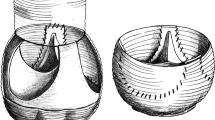Abstract
Background and Aims
This study investigated the long-term clinical course of patients with Schatzki rings, who were treated by single bougie dilation. Furthermore, it analyzed possible predictors for the time of recurrence.
Patients and Methods
A total of 133 patients (100 males, 33 females) with a mean age of 57 ± 14.6 years who were treated by single dilation with the use of Maloney bougies without the aid of fluoroscopy were prospectively registered and followed-up for a mean duration of 58.3 months (range 12–240 months). Duration of remission was evaluated by Kaplan–Meier estimates with regard to recurrence. Log-rank test was performed to analyze possible predictors for the time to second dilation (recurrence).
Results
No complications occurred and all patients were symptom-free at the first follow-up examination 4 weeks after dilation. However, later on, 73 patients required a second dilation. The estimate remission rates were 63.8% (95% CI: 55.6–72.0%) after 2 years, 44.3% (95% CI: 35.4–53.4%) after 5 years, and 39.9% (95% CI: 30.5–49.3%) after 10 years. Neither the initial morphological findings, nor age or gender determined the need for repeated dilation. Only patients treated with a large bougie diameter (≥52 F) seemed to have a tendency for a longer time until symptomatic recurrence.
Conclusions
Single dilation of symptomatic Schatzki rings is a safe and effective therapy. However, more than half of the patients will need a second treatment. Recurrences are unrelated to initial morphological findings, age, or gender. Only the treatment with a large bougie diameter (≥52 F) showed a tendency for a longer time of remission.



Similar content being viewed by others
References
Schatzki R, Gary JE. Dysphagia due to a diaphragm-like localized narrowing in the lower esophagus (lower esophageal ring). Am J Roentgenol Radium Ther Nucl Med. 1953;70:911–922.
Goyal RK, Glancy JJ, Spiro HM. Lower esophageal ring. (First of two parts). N Engl J Med. 1970;282:1298–1305.
Longstreth GF, Longstreth KJ, Yao JF. Esophageal food impaction: Epidemiology and therapy. A retrospective, observational study. Gastrointest Endosc. 2001;53:193–198.
Schatzki R, Gary JE. The lower esophageal ring. Am J Roentgenol Radium Ther Nucl Med. 1956;75:246–261.
Kramer P. Frequency of the asymptomatic lower esophageal contractile ring. N Engl J Med. 1956;254:692–694.
Keyting WS, Raker G, McCarver RR. The lower esophagus. Am J Roentgenol Radium Ther Nucl Med. 1960;84:1070–1075.
Marshall JB, Joseph M, Kretschmar M, Diaz-Arias AA. Gastroesophageal reflux as a pathogenic factor in the development of symptomatic lower esophageal rings. Arch Intern Med. 1990;150:1669–1672.
Nurko S, Teitelbaum JE, Husain K, Buonomo C. Association of Schatzki ring with eosinophilic esophagitis in children. J Pediatr Gastroenterol Nutr. 2004;38:436–448.
Longstreth GF. Familial lower esophageal rings. N Engl J Med. 1982;307:443.
Stiennon OA. The anatomic basis for the lower esophageal contraction ring. Am J Roentgenol Radium Ther Nucl Med. 1963;90:811–822.
Postlethwait RW, Musser AW. Pathology of lower esophageal web. Surg Gynecol Obstet. 1965;120:571–575.
Ottinger LW, Wilkins EW. Late results in patients with Schatzki rings undergoing destruction of the ring and hiatus herniorrhaphy. Am J Surg. 1980;39:591–594.
Guelrud M, Villasmil L, Mendez R. Late results in patients with Schatzki ring treated by endoscopic, electrosurgical incision of the ring. Gastrointest Endosc. 1987;33:96–98.
Wills JC, Hilden K, Disario JA, Fang JC. A randomized, prospective trial of electrosurgical incision followed by rabeprazole versus bougie dilation followed by rabeprazole of symptomatic esophageal (Schatzki’s) rings. Gastrointest Endosc. 2008;67:808–813.
DiSario JA, Pedersen PJ, Bichis-Canoutas C, Alder SC, Fang JC. Incision of recurrent distal esophageal (Schatzki) ring after dilation. Gastrointest Endosc. 2002;56:244–248.
Chotiprasidhi P, Minocha A. Effectiveness of single dilation with Maloney dilator versus endoscopic rupture of Schatzki’s ring using biopsy forceps. Dig Dis Sci. 2000;45:281–284.
Eastridge CE, Pate JW, Mann JA. Lower esophageal ring: Experiences in treatment of 88 patients. Ann Thorac Surg. 1984;37:103–107.
Mossberg SM. Lower esophageal ring treated by pneumatic dilatation. Gastroenterology. 1965;48:118–121.
Groskreutz JL, Chung HK. Schatzki’s ring: Long-term results following dilation. Gastrointest Endosc. 1990;36:479–481.
Eckardt VF, Kanzler G, Willems D. Single dilation of symptomatic Schatzki rings. A prospective evaluation of its effectiveness. Dig Dis Sci. 1992;37:577–582.
Savary M, Miller G. The esophagus. Handbook and atlas of endoscopy. Solothurn, Switzerland: Verlag Gassmann AG; 1978:135–139.
Tobin RW. Esophageal rings, webs, and diverticula. J Clin Gastroenterol. 1998;27:285–295.
Rohrmann CA Jr. When is a Schatzki ring clinically significant, and what is the best maneuver to demonstrate it on barium swallow? Does the abnormality progress if it is not treated? Am J Roentgenol. 1994;163:215.
Kaplan EL, Meier P. Nonparametic estimation from incomplete observations. J Am Stat Assoc. 1958;53:457–481.
Schatzki R. The lower esophageal ring: Long-term follow-up of symptomatic and asymptomatic rings. Am J Roentgenol Radium Ther Nucl Med. 1963;90:805–810.
Sgouros SN, Vlachogiannakos J, Karamanolis G, et al. Long-term acid suppressive therapy may prevent the relapse of lower esophageal (Schatzki’s) rings: A prospective, randomized, placebo-controlled study. Am J Gastroenterol. 2005;100:1929–1934.
Scharschmidt BF, Watts HD. The lower esophageal ring and esophageal reflux. Am J Gastroenterol. 1978;69:544–549.
Ott DJ, Ledbetter S, Chen MYM, Koufman JA, Gelfand DW. Correlation of lower esophageal mucosal ring and 24 h-pH monitoring of the esophagus. Am J Gastroenterol. 1996;91:61–64.
Eckardt V, Dagradi AE, Stempien SJ. The esophagogastric (Schatzki) ring and reflux esophagitis. Am J Gastroenterol. 1972;52:525–530.
Sgouros SN, Vassiliadia K, Bergele C, Vlachogiannakos J, Stefanidis G, Mantides A. Single-session, graded esophageal dilation without fluoroscopy in outpatients with lower esophageal (Schatzki’s) rings: A prospective, long-term follow-up study. J Gastroenterol Hepatol. 2007;22:653–657.
Saeed ZA, Ramirez FC, Hepps KS, et al. An objective end point for dilatation improves outcome of peptic esophageal strictures: A prospective randomized trial. Gastrointest Endosc. 1997;45:354–359.
Conflict of interest
The authors of this article have no commercial associations that might be a conflict of interest in relation to this investigation.
Author information
Authors and Affiliations
Corresponding author
Rights and permissions
About this article
Cite this article
Müller, M., Gockel, I., König, J. et al. Long-Term Recurrence Rates Following Dilation of Symptomatic Schatzki Rings. Dig Dis Sci 56, 1432–1437 (2011). https://doi.org/10.1007/s10620-010-1427-7
Received:
Accepted:
Published:
Issue Date:
DOI: https://doi.org/10.1007/s10620-010-1427-7




